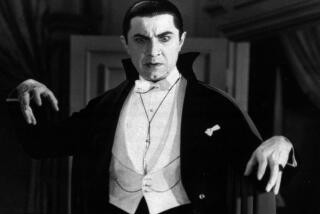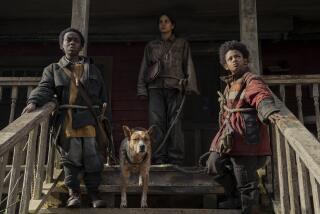As ‘Crimson Peak’ and ‘It Follows’ show, horror on film works on many levels
For many, the idea of horror films brings up bloody images with a visceral shock or nightmare monsters from somewhere deep in the subconscious. And certainly those are aspects to the appeal of horror, the way in which it creates a safely confined space to consider the darkest aspects of human behavior and the outer limits of societal codes. Something else that makes horror truly enduring and, dare one say, sophisticated, is the malleable elasticity of the form, the way in which horror and its explorations of the darkness within can be applied to different storytelling forms.
Anything can be horror and horror can be made from anything. Recently, filmmakers have especially reveled in cross-pollinating between genres and creating horror, or tinges of it, from the unlikeliest of places.
SIGN UP for the free Indie Focus movies newsletter >>

An inside look at Guillermo del Toro’s gothic romance movie “Crimson Peak.”
A film such as the recent “Ex Machina” may not be a horror film in the strictest of terms, but in grappling with what makes a human a human within a triangulated equation of man, woman and machine, it touches on the same kind of body horror as early David Cronenberg films or Ridley Scott’s original “Alien.”
Recent films that bend horror to their own ends include the tale of teen infection “It Follows,” the knowing but heartfelt comedy “The Final Girls,” the family dramas of “The Witch,” “Goodnight Mommy” and others.
Newly opening is “Crimson Peak,” the latest from filmmaker Guillermo del Toro and something that purposefully pushes the boundaries of what can be considered a horror film. A high-style period ghost story tinged with romance, the film is described by Del Toro as “heightened melodrama layered with a lot of darkness and the Gothic atmosphere of a dark fairy tale that is both creepy and eerie.”
Set in the early 20th century, “Crimson Peak” sees Edith Cushing (Mia Wasikowska) wooed away from the cozy affluence of her home in Buffalo, N.Y., after her industrialist father suddenly dies. She relocates to England with her new husband Thomas Sharpe (Tom Hiddleston) to live on a secluded and crumbling estate with his sister Lucille (Jessica Chastain).
Del Toro (who co-wrote the film with Matthew Robbins) is sharp enough to tease at the unlikely hybrid he is creating with playful nods. The young, innocent Edith is an aspiring fiction writer and after having name-dropped “Frankenstein” author Mary Shelley, she tells someone that a story she has written is not so much a ghost story but rather “a story with a ghost in it.” She subsequently tries to explain more than once what the ghost in the story really means, proclaiming it a metaphor for the past.
Later in the film, as the story takes darker, psychosexual twists that find the house crumbling and the sumptuous fabrics of the characters’ magnificent clothes torn and bloodied, a character says by way of explanation, “The horror, the horror was for love.”
That use of horror as a framework for examining relationships is frequent in recent films, as in the mother-child dynamic of Jennifer Kent’s “The Babadook,” or a circle of friends in Karyn Kusama’s “The Invitation.” Writer-director David Robert Mitchell previously made the bittersweet, observant teen drama “The Myth of the American Sleepover” and so on the face of it there was surprise in him moving on to a horror film like “It Follows,” a small-scale hit earlier this year.
Except that “It Follows” has some of the same thematic ideas as “Myth”; it takes on the anxiety of maturity and the feeling that there are some things in life that cannot be undone. Lest all that sound too earnest, “It Follows” is also a chilling tale of a sexually transmitted curse.
“The Final Girls,” starring Taissa Farmiga and Malin Akerman — and not to be confused with the recent film “Final Girl” starring Abigail Breslin — is spoofy and funny, self-consciously aware of the tropes of the horror film, while also displaying a certain reverence and affection for them too. The film’s very title comes from an idea put forth by Carol J. Clover in her book, “Men, Women and Chain Saws: Gender in the Modern Horror Film,” regarding the way in which horror movies often leave one last surviving female to fight the murderous boogeyman at the end.
That sort of self-awareness is not new, of course, being a cornerstone of the “Scream” franchise and many horror films well before that. The 1982 film “The Slumber Party Massacre” — playing soon at L.A.’s Cinefamily as part of a series of ‘80s horror films directed by women — is among the best examples of a movie that looks like shameless, unabashed trash, but turns out to be made so smartly and with such unexpected conviction that it transcends into something more. Directed by Amy Holden Jones and written by author Rita Mae Brown, the film is full of surprises.
Another distinct take on the horror film is “The Witch,” the debut feature by writer-director Robert Eggers, which has received great response on the festival circuit and will be released early next year. Set in 17th-century New England, the film opens with a family being cast out of its village that soon comes to believe its oldest daughter (Anya Taylor-Joy) is practicing witchcraft.
A slowly bubbling concoction of paranoia and cross-accusations will be familiar to anyone who has felt the world spinning out-of-control away from them, with the period setting providing enough estrangement to keep it creepy. The film features a goat named Black Phillip for something of a villain and he has already proved so popular with audiences he has a twitter account (@BlackPhillip).
Horror can even sometimes unexpectedly crash the upscale environs of the movie academy. Austria’s submission for this year’s foreign language Oscar is the darkly disturbing “Goodnight Mommy,” Veronika Franz and Severin Fiala’s tale of twin boys who believe their mother is someone else after plastic surgery. Festivals such as the Midnight Madness section of the Toronto International Film Festival, Austin’s Fantastic Fest or Los Angeles’ own Beyond Fest all feature work that pushes the limits of what can be considered horror films.
Horror, in grappling with the dark and unknown undercurrents of human psychology and society, will likely never run out of material — do you expect all of humanity to clean up its act any time soon? Yet the way in which horror can also work either as a foundation for a story or as an element of overlaid filigree also ensures its longevity.
These surprising recent entries to the horror landscape keep audiences guessing about not just what’s around the corner but also whether they’re watching conventional horror or some strange, previously unseen hybrid, like a monster from the unknown. Whether in the dark of a movie theater or against the inviting glow of a personal screen, anything can happen.
Twitter: @IndieFocus
MORE:
‘Crimson Peak’s’ visual marvels overshadow Del Toro’s ghostly story
R.L. Stine reveals his most gruesome scene ever
‘Edward Scissorhands’ at 25 still stands the test of time
For Guillermo del Toro, home is where the horror is in ‘Crimson Peak’
More to Read
The biggest entertainment stories
Get our big stories about Hollywood, film, television, music, arts, culture and more right in your inbox as soon as they publish.
You may occasionally receive promotional content from the Los Angeles Times.











